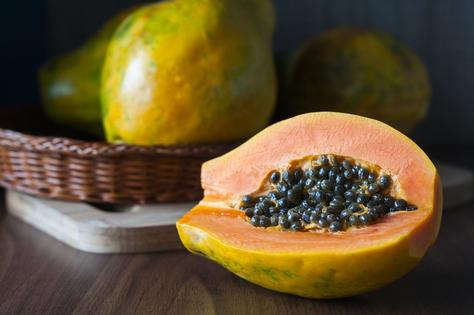Environmental Nutrition: Papaya power!
Cut into a papaya and behold the spectacular shades of sunset in the tropics--rich pink, deep orange, and glowing yellow. A favorite tropical repast, it's no surprise this fruit is native to warm, humid southern Mexico and Central America.
The folklore
Ancient Mayans, who both ate papaya and used it to heal skin problems, called the papaya tree, "tree of life." The papaya is also said to have cured Christopher Columbus' crew of their digestive problems. With a long list of folk medicines and cures to its name, this sweet, buttery-textured fruit is ripe with vitamins, minerals and health-protecting plant compounds.
The facts
The papaya (Carica papaya L.) is a tree-like plant with palm-like leaves and flowers like small white plumeria. Oblong or pear-shaped, wrapped in a thin, tough skin of green, yellow or orange, the melon-like fruit's smooth, juicy flesh surrounds a cluster of small, black seeds. The most common varieties are Hawaiian -- small (about one pound) and pear-shaped with orange or pink flesh, and Mexican -- up to 15 inches and 10 pounds with yellow, orange or pink flesh that's less sweet than Hawaiian. One-cup serves up 144 percent Daily Value (DV) of antioxidant vitamin C, 31 percent DV of eye-protecting vitamin A, as well as powerful phytochemicals beta-carotene and lycopene, the source of papaya's rich color.
The findings
Antioxidant-rich papaya may help improve aging skin, according to a study published in Experimental and Therapeutic Medicine, 2016. A fermented papaya preparation improved skin antioxidant capacity and signs of aging skin (including skin moisture, brown spots and elasticity) more effectively than an antioxidant cocktail containing trans-resveratrol, vitamins C and E, and selenium. Papaya's antioxidant potential is being studied in lab and animal studies for its ability to help control blood glucose in patients with type 2 diabetes, and to help fight inflammation and oxidation to protect against cancers (Mutation Research, 2014).
The finer points
Early summer and fall are peak season for papaya, but they are available year round. Hawaiian papaya is ripe when it's mostly yellow, while the Mexican variety will be green-yellow with shades of orange. They will give to gentle pressure and should be free of bruised or wrinkled areas. Refrigerate ripe fruit up to three days. Peel and scoop out seeds. Fill the hollow with fresh or frozen yogurt topped with nuts or granola for a satisfying breakfast or dessert. Enjoy papaya drizzled with lime juice, added to salads and smoothies, or try them as a vegetable -- baked, boiled or stuffed.
...continued







